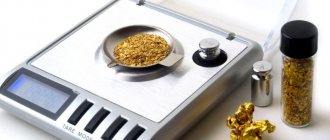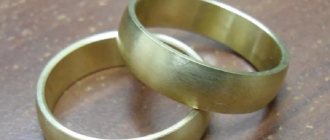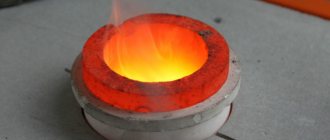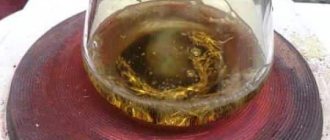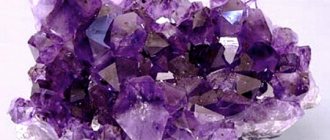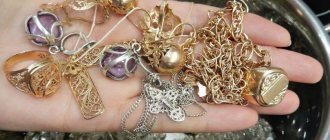Gold at all times does not leave humanity indifferent. Extracting it from stone is a very complex process. Being absolutely unsuitable for farming, due to its beauty, amazingness and inaccessibility, it has become one of the means of payment and material for the manufacture of expensive jewelry.
The extraction of precious metal is of interest to many people, especially lovers of expensive jewelry, swindlers and adventurers. But finding gold is not so easy. There are practically no large deposits left; finding them is difficult, but possible.
Searchers are looking for ways to mine in those places where work was carried out during Soviet times. Many believe that there is a high probability of finding the precious metal in huge quantities. This opportunity is provided due to the fact that the site was mined industrially.
Gold in nature: where it is found
Gold is found on our planet:
- in plants - some species are able to accumulate metal obtained along with nutrients from the soil;
- in the water of seas, oceans and other bodies of water - extracting a mineral from the hydrosphere is a costly and not always profitable technology;
- in stones - most of the metal mined industrially is obtained from rocks.
Gold in its pure form is very rare in nature. Due to constant exposure to the elements, sometimes gold inclusions are leached from the rock and formed into nugget ingots, as the natural alloy of this metal is called.
But more often, in order to separate pure gold from a stone, it is necessary to carefully process the mined rock.
Helpful information! Gold-bearing rocks in most cases occur among quartz formations and sulfide ores. Prospectors, having found such an accumulation of minerals, confidently judge the feasibility of developing the layers.
Processing of gold ores[edit | edit code]
Main article - Beneficiation of gold ores
Placers and conglomerates are processed using gravity schemes. After gravity concentration, flotation can be used to increase the recovery of fine grains of gold. Bedrock ores are enriched mainly using combined schemes using flotation.
Schemes and modes of ore processing significantly depend on their mineral composition, destruction, the presence or absence of impurities that complicate the extraction of gold, as well as on the size of gold particles.
Searching for gold in Russia
Since ancient times, following the thirst for profit and believing in myths about rich deposits, the rulers of Rus' organized searches for gold. But, despite the vastness of the Russian State, efforts were in vain:
- Prince John III the Great invited foreign specialists to achieve this goal, investing substantial funds in resolving the issue. But all efforts were crowned with only a few peas of the coveted metal, which were not enough even for a pectoral cross;
- Tsar Ivan the Terrible, in pursuit of treasures, went to conquer the lands of distant Siberia, but also failed in his search.
In 1945, a resident of a Ural village found a large yellow ingot during excavation work. He showed the find to a master he knew, who identified it as pure gold. The Soviet authorities sent gemologists to the site where the nugget was discovered, who studied the area in detail and confirmed the presence of huge deposits of the precious metal, and soon a mine opened there. This development marked the beginning of centralized gold mining in the RSFSR.
Today, Russia ranks third, after Australia and China, in gold production. The largest locations are in the Far East and Siberia:
- Magadan region - 180 gold mining enterprises extract more than thirty tons of raw materials from the subsoil per year;
- Chukotka - more than twenty-five tons of annual production;
- Yakutia is the richest region. There are over eight hundred gold mines here, yielding more than twenty-four tons of raw materials per year;
- The Irkutsk region ranks fourth, with production volumes of more than twenty-three tons per year.
In addition to the listed regions, gold is mined in the Amur, Chelyabinsk, Sverdlovsk regions, the republics of Bashkiria and Buryatia, the Khabarovsk and Trans-Baikal territories.
Home techniques
Industrial gold mining differs significantly from private gold mining, and the methods used have many advantages. If you know how to identify gold in a stone, you can successfully remove it from there using the most primitive methods.
And you don’t have to go to distant Siberia in search of abandoned mines. You can implement the idea of withdrawing precious metals at home. Back in the days of the Soviet Union, skilled craftsmen extracted it from old watches and other yellow metal products. In the recent past, gold plating was present on many radio components and household appliances, which was justified by its practicality and resistance to corrosion. Without a doubt, the percentage of gold content in such objects is negligible, but in the rock it is not that high.
If you want to get the precious yellow material at home, just take an old wristwatch and then fill it with nitric acid in glass or plastic containers. The substance will quickly dissolve any materials except gold. The resulting solution must be carefully passed through several layers of gauze, and the seized gold must be infused in vodka for 24 hours. This will result in a brownish tint.
In the future, it is necessary to rinse the composition with plain water, filter again and put on low heat to melt. To improve the efficiency of the latter process, soda is added to the gold. We must not forget about the ability of the yellow metal to evaporate, but through melting it is cleared of excess impurities and becomes like a tiny ingot.
Gold can also be extracted from radio components , in which it was used back in the Soviet Union due to its inertness and minimal electrical conductivity.
To implement such an idea, you need to use “regia vodka”, which consists of nitric and hydrochloric acid. Such a substance can dissolve gold at room temperature. By the way, there are historical facts about the dissolution of gold medals in order to hide them from the fascist military. Under the influence of aqua regia, gold precipitates, after which it is thoroughly filtered and washed.
Extracting gold from stones
Developments in new technologies make it easy to extract gold from stone. But it is impossible to determine which mineral contains gold without special research. Many rocks, at first glance, look identical to containing this precious metal, with a similar structure and color range - from red to orange. Therefore, even experienced jewelers are forced to use high technology to distinguish gold from minerals:
- pyrite;
- chalcopyrite;
- pentlandite;
- pyrophyllite;
- mica.
To recognize the presence of a gold-bearing stone in a rock, the mineral must be crushed with a hammer, assessing the result by the presence of the following signs:
- the inclusions of gold will be flattened;
- semi-precious stones and minerals will be crushed into crumbs;
- the mica will crumble into sand.
Note! Some stones that look like gold-containing ones and form flattened inclusions under mechanical stress may turn out to be without precious metal content.
What does it look like?
Gold occurs in nature in the form of nuggets, fine-grained placers, and powder dust. It is included in the veins of stones and rocks. By law, stones found with gold inclusions are transferred to refineries.
Gold in stones can be found in mountain rivers, rocks, mountains, sand of seas and lakes, ore mixed with other minerals. It is difficult to get it from there without loss. It is also necessary to determine whether this substance is a noble metal, and not iron pyrite or zinc blende. Pyrite and other minerals, similar in their luster to yellow precious metal, crumble if they are scratched with a needle. Gold from stones does not crumble, but is scratched, like other metals.
Gold inclusions in stone
The satellites of gold sands and placers are very similar to the precious element, but they can be distinguished from each other. Often gold is accompanied by intrusive rocks formed as a result of solidification of magma - these are quartz diorites and granite, quartz. Chalcopyrites, galerites, pyrites, antimonites, sphalerites, and arsenopyrites are also considered neighbors of the precious element. It is quite difficult to obtain gold from granite; special technologies are required.
Zinc blende, or sphalerite, is a dark-colored rock (black or brown) with a characteristic shine. Occurs in the form of crystals. It scratches easily, unlike precious metal, and crumbles.
Gold is obtained from stones using different chemical methods. Lead sulfite is called galena, or lead luster. It can be broken with a hammer into cubes into which the mineral was divided using adhesive cracks.
Arsenopyrite is an arsenic sulfite that emits a garlicky odor when destroyed.
Antimony sulfite, that is, stibnite, is a rock that accompanies gold, has a luster like lead, and the color of the mineral is grayish-black. Its crystals are needle-shaped and can be included in a quartz crystal.
Limonite has a brown-orange or ocher color. This mineral, also called iron ore, is one of the most common satellites of gold. Quartz veins often contain limonite crystals. Gold is extracted from stones of the brown mineral limonite through complex processing with acids and electrolytic transformations. May contain large amounts of metal.
The iron ore mineral forms brownish-brown iron caps on sulfite bodies. Gold from stones is obtained in many cases from iron ore ore, which contains many impurities of the noble metal. This is done by gold mining enterprises accredited by the state.
Quartz and quartz diorites also contain a lot of precious metal. They accompany it in rocks; in rivers you can see gold from stone and in sand along with quartz crystals, from the veins of which gold dust scatters and can be carried along rivers. Sometimes it can settle in silt and soil, sand, on pebbles at the bottom of rivers and lakes, on the coasts of seas and even oceans. Small particles of metal are presented in the form of gold placers.
What does gold look like in quartz? There are quartz rocks of different types - coarse-grained, fine-grained, layered, banded, confluent with inclusions of another mineral - rock crystal. Quartz with inclusions of gold has a yellowish-brown color. It’s hard not to notice such a mineral.
Gold and sand are frequent companions in nature, especially at the bottom of rivers and lakes. There are several types of gold placers:
- Alluvial - formed by breaking rocks and transporting placers along rivers.
- Eluvial - ore bodies that are not washed away by rivers and occur in watersheds.
- Colluvial - destroyed rocks containing gold. They occur on the slopes of mountains and the coasts of seas and lakes.
Gold from stone and sand is mined in rivers, lakes, and mountains using special equipment. Placers can be found with special metal detectors by setting the desired frequency.
There are different types of placers, which, in addition to gold, also contain other valuable rocks - wolframite, osmium and iridium impurities, cassiterite, ilmenite (titanium). Gold from stones can fall out due to a fault, forming placers of dust. Channel, spit, valley, terrace, and spoon placers contain gold and other minerals. There is no peat in river beds, in which it is impossible to find golden grains of sand. Spit placers are located on shallows and spits in the form of floating particles.
Conclusion
Gold refining from stone is carried out by special enterprises that have a license for this type of activity. Visible gold lies in rocks; ores are processed in a special way to separate the metal from other minerals and impurities of chemical elements.
Hello dear readers. Did you know that gold ore is scattered all over the world and is very common in rocks. You can meet it simply by walking along the rocky spurs. In this article we will talk not only about where you can find precious metal, but also about how to recognize and extract gold from a stone.
Modern mining technologies
The mined ore from the quarry is delivered by dump trucks to the processing plant, where the raw materials undergo primary processing:
- sorting, depending on the percentage of metal;
- mixing batches to form a homogeneous composition according to the degree of gold presence;
- screening out large inclusions, which are separately subjected to additional grinding;
- grinding of raw materials into a dusty mass and subsequent enrichment with the addition of water, preparation of material ready for processing by flotation - saturation with air;
- introduction of chemical reagents that promote the separation of gold;
- foam is selected from the resulting composition (directly – gold suspension), thickened using special reagents;
- the next stage is squeezing out excess water in press filters;
- The dehydrated material is dried in ovens at high temperatures and crushed.
One ton of the concentrate obtained after processing contains up to fifty grams of gold.
The products of the processing plant are finally converted into precious metal after smelting at a hydrometallurgical plant.
Endogenous gold ores[edit | edit code]
All endogenous gold ores are of hydrothermal origin. The Au content ranges from 2-3 to several hundred g/t. They form massive plate-like, saddle-shaped veins, pipe-like bodies, veinlet and stockwork deposits.
Rich gold-quartz ore
The composition of gold-bearing ores is varied (up to 200 minerals). Gold-sulfide-quartz ores predominate. Calcium and iron carbonates, barite, chlorite, sericite, and tourmaline are present. Among the ore minerals, pyrite predominates, and arsenopyrite is less common. They are accompanied by pyrotin, sulfides and sulfosalts of copper, lead, zinc, bismuth, silver, iron oxides, native silver, bismuth, and in some cases tellurides.
How to extract gold from stone at home
At home, gold is extracted from stone in the following ways:
- dry, using chlorine - the name of the method is explained by the peculiarities of the technology. The stone is crushed into powder as much as possible, then chlorine gas is introduced into the composition, which binds all other minerals except gold through a chemical reaction. The technique is dangerous, requiring skill and experience from the performer;
- chemical, which involves dissolving excess mineral components with aggressive acids;
- electrolysis - hydrochloric acid and gold chloride are added to a transparent container with ground stone. An electric current is connected to the mixture, as a result of the process gold settles into a sediment.
But amateur miners who want to resort to extracting gold from stone at home must take into account that in our country, illegal mining and sale of precious metals is prosecuted by law.
General characteristics[edit | edit code]
There are primary deposits (including veins with a gold content of 1...30 g/t) and placers in the form of alluvium (gold content of 0.5...50 g/m³). In addition to gold-bearing ores themselves, gold-containing ores of copper, nickel, lead and zinc, silver, iron (ferruginous quartzites), and manganese, in which gold acts as an associated component, are known. More than 30 gold minerals have been discovered. The main industrial importance is native gold, secondary - kustelite (Au about 10-20%) and tellurides: calaverite - AuTe2 (40-43% Au), krennerite - (Au, Ag)Te2 (40% Au), sylvanite - (Au , Ag)Te4, (25-27% Au), petzite Ag3AuTe2 (25% Au). Rare - cuproauride - AuCu2, rhodite - Au, Rh, porpecite - Au, Pd, aurostibite AuSb2, maldonite Au2Bi, gold sulfide uytenbogardeite - Ag3AuS2, etc. Associated components of gold ores - Ag, Cu, Pb, Zn, Bi, As, Sb , Te, Hg, W, Sn, Co, Ni.
The healing effects of golden sand
The healing properties of aventurine have been known for as long as the magical ones. Lithotherapists recommend using this stone in the following situations:
- To cleanse the body and improve metabolic processes.
- To prevent the formation of blood clots and normalize the functioning of the heart and blood vessels. Wearing pendants, rings or bracelets with dark red aventurine helps stabilize blood pressure.
- To reduce inflammation and pain resulting from injury.
- For migraines to relieve pain.
To improve the growth and development of children.- To relieve fatigue and improve performance. The stone is good at calming the nerves.
- To improve vision.
- The black variety has long been used to treat diseases of the musculoskeletal system.
- Wearing jewelry with aventurine helps improve the condition of the skin, hair and nails. A good effect is observed for eczema, hair loss, skin rashes. You can even remove warts with the help of aventurine.
- To improve the condition of the respiratory system and protect against bronchitis or colds, experts recommend wearing aventurine beads.
Traditional oriental medicine uses balls of this stone for massage. This way you can relieve muscle spasms and strengthen your joints.
It should be noted that it is not advisable to wear aventurine on the body all the time. To improve your health, you need to wear products with the mineral during the waning phase of the moon.
It is strictly contraindicated to wear jewelry with aventurine for more than a month in a row, no matter the severity of the disease. This can lead to excessive activation of energy processes in the body and the development of energy imbalance
. Lithotherapists consider the optimal regimen to be wearing jewelry or amulets for 7 days, after which a two-day break is taken.
Jewelry and care
There are many techniques for cutting minerals. To create jewelry, cabochons are most often made: on one side the surface of the product is flat, on the other it is convex and smooth.
Rings, beads, pendants, earrings and bracelets are made as jewelry. In esoteric practice, all kinds of geometric shapes and animal figures are used.
It is often used as a decorative element in the manufacture of vases, candlesticks, boxes and other accessories.
Collectors highly value raw pieces of the mineral aventurine. Although aventurine is considered very hard and durable, it can be damaged under certain circumstances. To keep the stone in perfect condition for as long as possible, you should follow the following rules for caring for it:
- Avoid contact with sharp objects that can scratch the surface of the mineral.
- Other stones can scratch aventurine - beryl, corundum, diamonds.
- In addition to the safety of the stone itself, you should take care of the frame. It is recommended to store the jewelry in a separate box or bag so that it does not come into contact with the sharp edges of other jewelry.
- You can clean the mineral with a warm soapy solution.
- It is best to wipe the surface of the stone with a soft cloth. With its help you can remove traces of dirt and grease, fingerprints, and perfume stains.
- Products should not be stored in very warm places - this will negatively affect its quality.
It is not recommended to use abrasive cleaning agents such as tooth powder or active chemicals to clean jewelry.
To cleanse the mineral of negative energy, you can hold it under running water - in a stream or under a tap. You can take the stone out into the bright sun for a while - this charges it with positive energy. However, dark varieties are harmed by excess sunlight. With proper care and care for the product, the aventurine talisman will serve for many years without losing its beauty and valuable properties.
Photo and appearance
Aventurine is a type of quartz with a complex heterogeneous structure . During geological processes that lasted more than one million years, the base of the stone was compressed with microparticles of mica, goethite, hematite, iron hydroxides, and other substances. These components give the mineral its characteristic shiny appearance, random inclusions and heterogeneous structure, which is highly appreciated by jewelers and designers.
Do you already have such a stone?
Yellow Aventurine is compared to the sun, which you can hold in your hands, and blue and green stones fascinate with the beauty of the dark night sky and twinkling stars.
Magical qualities of the stone
Back in the Middle Ages, the extraordinary magical properties of this mineral were described. It is especially needed for those who lack luck and fortune. Energy allows you to achieve success in any endeavor and gain wealth. Thanks to it, the owner of the stone becomes more energetic and active.
Another wonderful ability of aventurine is the awakening of intuition and the manifestation of talents. It gives inspiration and recognition to creative people and helps them overcome a creative crisis.
Contrary to popular belief, the green variety is not a talisman for swindlers and card players. The mineral provides protection to lovers, protects their feelings and helps preserve love for many years. The green mineral is a symbol of family well-being. He is able to protect from damage and envy. A decoration with such a stone can be hung over a child’s crib to protect him from fears and illnesses.
Who is contraindicated for aventurine?
Not all people benefit from aventurine. For some categories, the energy of aventurine may be negative:
- People born under the constellations of Aries, Leo and Sagittarius may suffer significant financial losses and be disappointed in life. Traits of cynicism and fatalism appear in their character, and negative personality traits become aggravated. Such people turn into quarrelsome, hysterical individuals.
- Aventurine is not suitable for people born under the sign of Capricorn.
- People who are emotionally unbalanced and excitable should not wear jewelry with this mineral.
- The mineral is completely unsuitable for people holding responsible positions and strictly adhering to the rules. Although, it should be noted, such people never rely only on luck.
Even if aventurine suits you perfectly, you should not wear it for more than one lunar cycle. It is best to wear jewelry during the waning lunar phase.
If you do not adhere to these rules, capricious luck may turn away , and the owner of the stone will become emotionally unstable.
General information and history of the origin of the Aventurine stone
The first reliable data about the mineral appears in India. It was used as a snake charmer, since it was previously believed that the inorganics of Aventurine and the reptile animal interact with one another.
The gem was known back in Ancient Egypt and China, where it was honorably considered a valuable stone. The emperor's seal was made from the mineral. Now it is used as a decorative material for the production of boxes, vases, as well as exquisite jewelry and original accessories.
Translated from Italian, Aventurine means “by chance . Nowadays the name Aventurine quartz is also found. There are several versions of the origin of the name of the gem.
One of the most popular is the story of a little-known Venetian artist who poured several copper filings into a glass mass and obtained shiny glass, for which connoisseurs gave it the original and beautiful name “Aventurine”. Later it began to be applied to stone, which in its brilliance and brightness was similar to the glass invented by the master.
The European name was not accepted in Russia in the 17th–19th centuries. The shiny crystal was named "gold spark", "spark" in honor of its attractive appearance. In Russian, the word “gold spark” is consonant with “aventurine”. Its meaning is adventure, a risky operation. From an esoteric point of view, the name of the stone fully corresponds to its astral characteristics.
